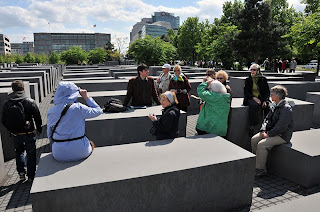We immediately took the U-Bahn to Alexanderplatz, a main square surrounded by modern buildings. We passed these food vendors in the square. Apparently they are not allowed to have any sort of fixed stand -- they have to hold everything they sell. Their vending equipment is strapped on to their bodies. One guy has also strapped on an umbrella.
This vendor was in a wheelchair, but he still has to hold everything.
We're at Pariser Platz, Unter den Linden, and the Brandenburg Gate.
A large square surrounds the Brandenburg Gate. The American embassy is on the left.
A bit closer, it doesn't seem quite so forbidding.
Gabriel showing pictures of the scene before the war.
The American embassy, and a horse-drawn carriage.
Berlin must be the New York of this part of Europe, because no one batted an eye at this guy in full American Indian regalia. No clue what he was promoting or protesting.
Taking a photo with the Brandenburg Gate in the background.
An artsy architectural shot of the Brandenburg Gate. Converging lines, horizontal vs. vertical, blue sky vs. gray stone -- the whole bit.
Pedal-powered cabs, like we saw in Dresden. Note the one on the right: there's a horse head mounted on the front.
The gate from the back and the side. These two shots were taken only five minutes apart, but see what a difference the sun coming out from behind the clouds makes.
Just a few blocks away is the nearly 5-acre site of Berlin's Holocaust Memorial. It consists of 2,711 concrete "stelae", identical in size except for height, arranged in a grid pattern. There are no signs saying what the memorial is or who or what it commemorates; visitors are supposed to draw their own conclusions.
An aerial view of the memorial. [Photo from Wikimedia Commons]
We spent some time walking through the memorial individually. The site dips and rises, so in spots the paths are much further below the tops of the stelae than at others.
I thought the memorial was very effective. It certainly gave me pause to consider the millions of people who where killed, and that each of the concrete blocks would represent more than a thousand of them.
We passed an extremely modern building as we walked to the remaining fragment of the Berlin Wall.
The path of the Berlin Wall is marked through the city on the streets and sidewalks. Here the double line of cobbles in the street marks the path, and it continues on the sidewalk as a stripe of a different color. The wall ran right next to the building seen in the background.
This short video clip shows the path of the wall, leading to the sections of the wall that have been left in place as a reminder.
Much of the wall was eventually made of precast concrete structures like these. The wall was double, with a no-man's land separating two actual walls.
Walking back, we passed the Potsdamer Platz railway station. Looking to the left, we had a good view of the East Berlin television tower that we first saw at Alexanderplatz. The East German government was very proud of the tower as a monument to modern socialism. The ball is covered in stainless steel panels, and they reflect the sun in the form of a cross. This was not intended by the designers, and was a source of embarrassment to the East German government. The appearance of the cross is referred to as "the Pope's revenge."
Back to the U-Bahn, to travel to Wilhelmstrasse. Many of the most important Nazi buildings were there; the only one remaining is Luftwaffe Headquarters. It's the huge gray building seen here, and now houses German government offices.
Gabriel showing what the square here used to look like. It was a large open place in which thousands of people used to gather to hear Hitler speak.
The Reich Chancellery was the most notorious building on Wilhelmstrasse. The photo Gabriel is holding shows Hitler on the balcony, addressing the multitude. All the people in the square are performing the Nazi salute. The Russians intentionally put up buildings on the square to eliminate the open gathering place that the Nazis had used, and tore down what remained of the Nazi buildings except for the Luftwaffe Headquarters.
This ended our tour of Berlin. I, for one, will have to come back; there's far too much to see in Berlin for one day.
Some people visited museums or other sites for the rest of the afternoon, while others took some down time back at the hotel. In the evening we went to Gabriel's home for dinner and a concert.




























































